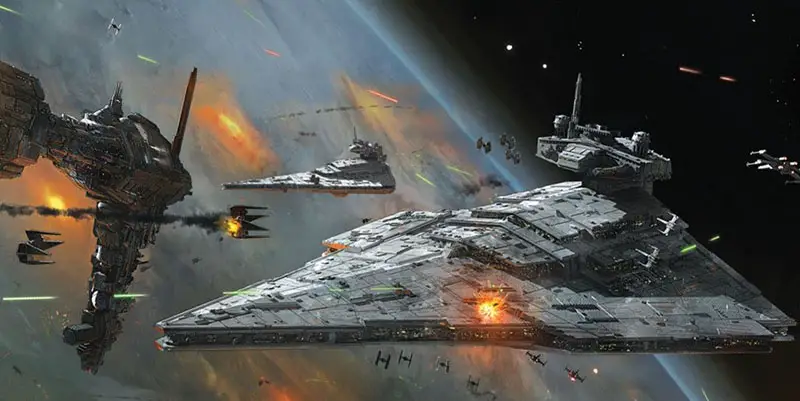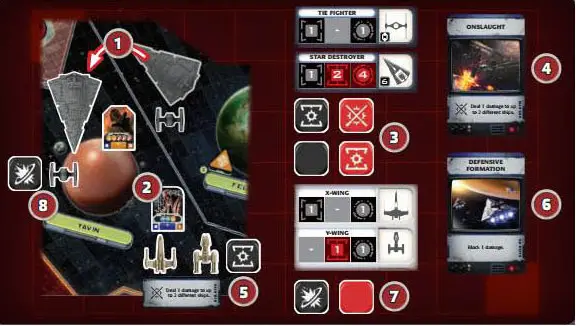
Combat
When a player moves units to a system that contains his opponent's units, a combat is resolved. Players resolve a combat by following these steps:
-
Add Leader: If a player does not have a leader with tactic values in the system, he may take one leader from his leader pool and place it in the system.
-

Draw Tactic Cards: Each player draws tactic cards based on his leader in the system (if any). The player draws space tactic cards equal to his leader's space tactic value (blue), and ground tactic cards equal to his leader's ground tactic value (orange).
If a player has multiple leaders in the system, he uses only the highest for each value (space and ground).
-
Combat Round: Players resolve a combat round in which each unit performs one attack. To resolve a combat round, follow these steps:
Space Battle: The current player resolves one attack with all of his ships. Then his opponent resolves one attack with all of his own ships. Only resolve this step if both players have ships in the system.
Ground Battle: The current player resolves one attack with all of his ground units. Then his opponent resolves one attack with all of his own ground units. Only resolve this step if both players have ground units in the system.
Retreat: Starting with the current player, each player has the option to retreat his units from the system.
Next Round: If both factions still have units in the same theater (space or ground), they resolve another combat round. Otherwise, the combat ends.

Resolving An Attack
To attack, the player rolls dice and deals damage to his opponent's units in that theater. To resolve an attack, follow these steps:
-

Roll Dice: The player rolls dice matching the color and quantity of the attack values of all his participating ships or ground units. Each attack is limited to a maximum of five red and five black dice.
-
Combat Actions: After rolling the dice, the player performs any number of combat actions, one at a time. There are two types of combat actions:
Play a Tactic Card: The player plays a tactic card from his hand and resolves its ability. Tactic cards can target only units in the theater being resolved and are discarded after use. If the card has the ?? icon, the player must discard one of his ?? dice to use the ability.
Draw a Tactic Card: The player can discard one of his ?? dice to draw one tactic card from this theater's tactic deck. Tactic cards can be used either during the same combat round in which they were drawn or saved for later in this combat.
-
Assign Damage: After the player is finished resolving combat actions, he chooses which units to assign damage to by placing the dice (or cards) next to the units. Damage must be assigned to units in the theater being resolved.
The icons on the dice can be used as follows:
 Hit: Deal one damage to a unit that has a health value matching this die's color.
Hit: Deal one damage to a unit that has a health value matching this die's color. Direct Hit: Deal one damage to a unit that has a black or red health value.
Direct Hit: Deal one damage to a unit that has a black or red health value.Example: TIE Fighters roll black dice. Any ?? rolled on black dice can be assigned to an opponent's unit in that theater with a black health value (only X-wings or Y-wings). Black ?? cannot be assigned to units with a red health value, such as a Corellian Corvette.
-
Block Damage: The opponent can play tactic cards to block (remove) damage assigned to his units. Blocked damage is canceled and does not affect the assigned unit.
-
Destroy Units: If a unit has damage assigned to it equal to or exceeding its health, it is destroyed (returned to the supply). If the unit has not yet attacked this combat round, it is not destroyed until the end of this combat step (either space battle or ground battle). The unit is placed on its faction sheet as a reminder that it will be destroyed at the end of this step. The unit attacks as normal this combat round.
If a unit is assigned damage that is less than its health value, place damage markers under the miniature to track the damage. This damage remains during future combat rounds and cannot be removed. All damage markers are discarded at the end of the combat.
Retreat
When a player retreats from combat, he moves his leader and all of his units from that system to an adjacent system, following normal movement and transport rules.
If a player does not have a leader in the system, he cannot retreat. If the Imperial player has a Death Star in the combat, he cannot retreat any of his units.
When retreating, the player must retreat to a system that either contains his own units or has one of his loyalty markers, if able. He cannot retreat units to a system that contains his opponent's units nor to a system that his opponent moved units from to initiate the combat.
Combat Example
1The Imperial player has activated the Yavin system with Darth Vader, moving one TIE Fighter and one Star Destroyer.
2. The Rebel player chooses to add Jan Dodonna to the system, taking him from his leader pool and placing him in the system.Both leaders have a space tactic value of "2", so each player draws two space tactic cards (not shown).
3The Imperial player attacks with his ships first. He rolls two black dice and two red dice.
4Now he performs combat actions.He discards his ?? die to use a ?? tactic card from his hand. This card deals one damage to two different units, so he deals one damage to each Rebel fighter.
5Next, the Imperial player assigns the black ?? to the Y-wing. The red ?? cannot be assigned to fighters because they do not have a red health value.
6The Rebel player plays a card to block one damage from the X-wing.The Y-wing has sustained lethal damage, so it will be destroyed at the end of this combat step.
7Then the Rebel player attacks with his ships. He rolls one black die and one red die. He chooses not to perform any combat actions.
8He decides to assign his black ?? to the TIE Fighter. The Imperial player does not block this damage, so the TIE Fighter will be destroyed.
9Both the Y-wing and the TIE Fighter are destroyed and returned to the supply.If both players had ground units in the system, they would then resolve a ground battle.
Continue Reading


